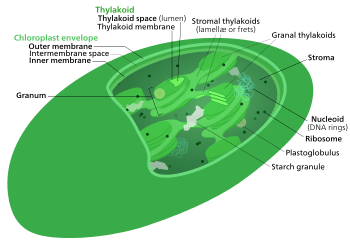TIC/TOC complex

The TIC and TOC complexes are translocons located in the chloroplast of a eukaryotic cell, that is, protein complexes that facilitate the transfer of proteins in and out through the chloroplast's membrane.[1] The TIC complex (translocon on the inner chloroplast membrane) is located in the inner envelope of the chloroplast.
The TOC complex (translocon on the outer chloroplast membrane) is located in the outer envelope of the chloroplast. It transports proteins that are synthesized in the cytoplasm across the chloroplast's membrane.
TOM/TIM complex vs. TOC/TIC complex

This protein complex is functionally similar to the TOM/TIM Complex located on the outer and inner membranes of the mitochondria, in the sense that it too transports proteins across multiple membranes and into the lumen of an organelle. Both complexes (TOM/TIM and TOC/TIC) are GTPases, that is, they must both hydrolyze ATP in order to power the translocation. The chloroplast also harnesses the power of an electrochemical gradient using protons. The gradient is only used to power transport across the thylakoid membrane, however, while the gradient in the mitochondria is used to power transport across its inner membrane.[2]
Furthermore, due to the Thylakoid membrane located inside of the chloroplast, a second transit peptide sequence must located on the imported protein. In the cytosol, a transit peptide that signals for transit of the protein to the chloroplast is exposed. This initiates transport and translocation through the TIC/TOC complexes into the stroma of the chloroplast. It is there that a signal peptidase cleaves the stromal transit peptide, only to reveal a second transit peptide sequence underneath; this time directing to the thylakoid membrane.[3]
See also
References
- ↑ "Preprotein Import into Chloroplasts via the Toc and Tic Complexes Is Regulated by Redox Signals in Pisum sativum".
- ↑ B. Alberts, A. Johnson, J. Lewis, et al., Molecular Biology of the Cell
- ↑ H. Li, C. Chiu, "Protein Transport into Chloroplasts"